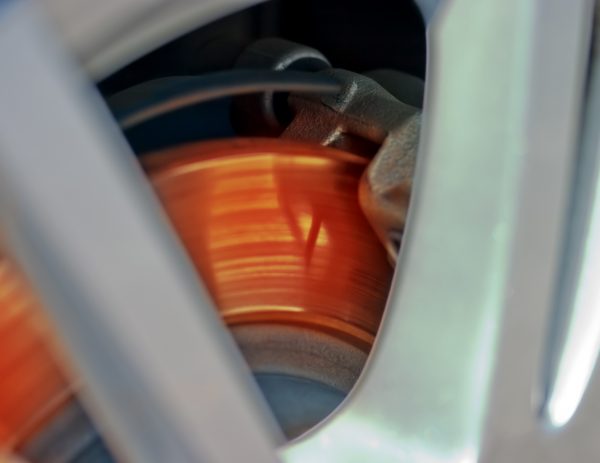Can I Use Dot 4 Instead Of Dot 3
DOT 3 and DOT 4 Brake Fluid: What's the Departure?
Nosotros break down the differences between DOT 3 and DOT iv restriction fluid.

The primary difference between DOT three and DOT 4 brake fluid is their respective boiling points.
I suspect I know your adjacent question.
Just offset, some background. The U.S. Department of Transportation (DOT) classifies brake fluid into four primary categories:
- DOT 3
- DOT iv
- DOT 5
- DOT 5.i
Their primary differences are their moisture & dry out boiling points and their limerick.
| Dry Humid Point | Wet Boiling Point | Limerick | |
|---|---|---|---|
| DOT three | 205°C/401°F | 140°C/284°F | Glycol Ether |
| DOT 4 | 230°C/446°F | 155°C/311°F | Glycol Ether/Borate Ester |
| DOT 5 | 260°C/500°F | 180°C/356°F | Silicone |
| DOT five.i | 260°C/500°F | 180°C/356°F | Glycol Ether/Borate Ester |
DOT 3 is the about common type used in cars and trucks today. DOT four, still, is gaining popularity due to widespread use of anti-lock braking systems and traction control, which benefit from DOT 4 fluid'due south lower viscosity.
Are DOT 3 and DOT four Brake Fluid Compatible?
Yes. DOT 3 restriction fluid is uniform with DOT iv brake fluid. Even so, DOT iv offers a higher boiling betoken.
DOT 5.1 is used in high-operation and heavy-duty applications due to its high humid point. Information technology's compatible with DOT 3 and DOT 4 fluid.
DOT 5 restriction fluid is silicone, meaning information technology doesn't absorb water. It's not compatible with the other brake fluids and is used generally in classic cars that remain in storage for long periods and need a restriction fluid that doesn't absorb h2o.
Bring it to a Boiling Bespeak
So, now we're back to boiling signal. What does it hateful? After all, we're not cooking this stuff.
Well, in the correct operating and ambient conditions, you are cooking it.

Aggressive braking tin lead to intense heat, which can vaporize the brake fluid, leading to a spongy pedal.
Braking generates intense heat between the brake pads and rotors. Perchance you've seen a race on Television set where the producers stick a GoPro under the car to testify the brakes literally glowing cherry when the driver depresses the pedal.
Intense heat tin vaporize restriction fluid, causing information technology to become compressible, which leads to a spongy feeling when you apply the brakes.
That leaves gas in the lines, which is compressible, leading to a soft pedal. In racing and operation-driving circles, this is known as brake fade, and it's something drivers actively desire to avert. To drive every bit effectively and safely every bit possible, the driver must be confident the brakes will perform on lap 10 as they did on lap one.
Brake fade can besides come from the brake pad/rotor interface. The pads release gasses, which reduces contact between the pads and rotors. That'due south why high-cease rotors are slotted and drilled – to release gasses quicker, limiting fade.
Restriction Fade Isn't Just for Racers
Descending a steep hill, specially when hauling a heavy load or towing a trailer, tin can generate tremendous heat if you ride or pump the brakes.
Past the time you lot accomplish the lesser, your pedal may go nearly to the flooring, making your heart charge per unit get well-nigh through the roof.
PRO TIP: Next time, downshift into a lower gear before descending a steep incline.
If y'all similar to toss your vehicle around a curvy country road for a picayune therapy, standing on the brakes going into corners can create sufficient oestrus to cause brake fade, as well. If you lot get a little too zealous, you may end upwards going correct through a corner and into the woods.
The fluid'south boiling point indicates the temperature at which the brake fluid vaporizes. The higher the DOT classification, the higher the humid bespeak, thus the better the fluid is at resisting heat. That's why racers use DOT 4, not DOT 3, brake fluid.
Boiling Indicate is Separated Into Dry out & Wet Boiling Points
The dry boiling point is determined using fresh fluid straight from a new container. The fluid's wet boiling point is determined using fluid that's been contaminated with three.7% h2o, thus it'due south always lower than the dry out humid point. Why would test administrators contaminate good fluid? Considering information technology'south a reflection of what happens in the real world.
Brake fluid is hygroscopic, meaning it absorbs water (except silicone-based DOT five restriction fluid). DOT 3 fluid, for case, tin blot upwardly to 2% water every twelvemonth. Moisture can enter the system when you remove the reservoir cap to add together fluid, through worn seals and even through the safe brake lines themselves. Thus the fluid'southward wet boiling point is the number that more than accurately represents what's really going on in your vehicle.
Since brake fluid tin wear out, information technology's vital y'all alter it periodically. Otherwise, not only will your brakes go spongy and unsafe, the moisture volition slowly corrode metal components.
A good rule of thumb is to change the brake fluid every other twelvemonth in passenger vehicles, and at to the lowest degree every year in racing vehicles. The AAA says 88% of motorists overlook brake maintenance, and so you're not alone if you lot haven't inverse restriction fluid in awhile, like since you lot bought your vehicle.
It's not as well late to start, though. And when you do, check out our line of restriction fluids for your vehicle.
Watch At present: How to Bleed Brakes
More than like this
Can I Use Dot 4 Instead Of Dot 3,
Source: https://blog.amsoil.com/dot-3-and-dot-4-brake-fluid-whats-the-difference/
Posted by: boardmorive.blogspot.com


0 Response to "Can I Use Dot 4 Instead Of Dot 3"
Post a Comment